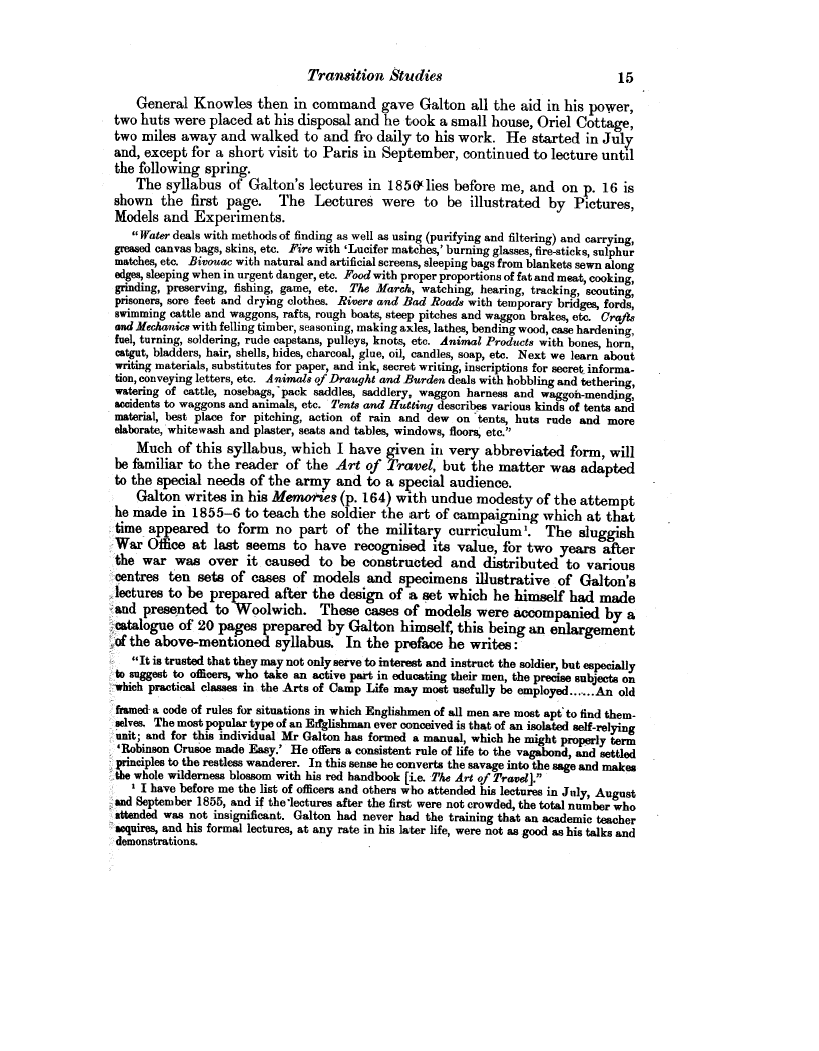Transition Studies 15
General Knowles then in command gave Galton all the aid in his power, two huts were placed at his disposal and he took a small house, Oriel Cottage, two miles away and walked to and fro daily to his work. He started in July and, except for a short visit to Paris in September, continued to lecture until the following spring.
The syllabus of Galton's lectures in 18 5 ( lies before me, and on p. 16 is shown the first page. The Lectures were to be illustrated by Pictures, Models and Experiments.
"Water deals with methods of finding as well as using (purifying and filtering) and carrying, greased canvas bags, skins, etc. Fire with `Lucifer matches,' burning glasses, fire-sticks, sulphur matches, etc. Bivouac with natural and artificial screens, sleeping bags from blankets sewn along edges, sleeping when in urgent danger, etc. Food with proper proportions of fat and meat, cooking, grinding, preserving, fishing, game, etc. The March, watching, hearing, tracking, scouting, prisoners, sore feet and drying clothes. Rivers and Bad Roads with temporary bridges, fords, swimming cattle and waggons, rafts, rough boats, steep pitches and waggon brakes, etc. Crafts and Mechanics with felling timber, seasoning, making axles, lathes, bending wood, case hardening, fuel, turning, soldering, rude capstans, pulleys, knots, etc. Animal Products with bones, horn, catgut, bladders, hair, shells, bides, charcoal, glue, oil, candles, soap, etc. Next we learn about writing materials, substitutes for paper, and ink, secret writing, inscriptions for secret information, conveying letters, etc. Animals of Draught and Burden deals with hobbling and tethering, watering of cattle, nosebags,-pack saddles, saddlery, waggon harness and waggon-mending, accidents to waggons and animals, etc. Tents and Hutting describes various kinds of tents and material, best place for pitching, action of rain and dew on tents, huts rude and more elaborate, whitewash and plaster, seats and tables, windows, floors, etc."
Much of this syllabus, which I have given in very abbreviated form, will be familiar to the reader of the Art of Travel, but the matter was adapted to the special needs of the army and to a special audience.
Galton writes in his Memorhies (p. 164) with undue modesty of the attempt he made in 1855-6 to teach the soldier the art of campaigning which at that time appeared to form no part of the military curriculum'. The sluggish War Office at last seems to have recognised its value for two years after the war was over it caused to be constructed and distributed to various centres ten sets of cases of models and specimens illustrative of Galtori s lectures to be prepared after the design of a set which he himself had made and presented to Woolwich. These cases of models were accompanied by a catalogue of 20 pages prepared by Galton himself, this being an enlargement of the above-mentioned syllabus. In the preface he writes
"It is trusted that they may not only serve to interest and instruct the soldier, but especially to suggest to officers, who take an active part in educating their men, the precise subjects on which practical classes in the Arts of Camp Life may most usefully be employed An old
framed- a code of rules for situations in which Englishmen of all men are most apt to find themselves. The most popular type of an Edglishman ever conceived is that of an isolated self-relying unit; and for this individual Mr Galton has formed a manual, which he might properly term 'Robinson Crusoe made Easy.' He offers a consistent rule of life to the vagabond, and settled principles to the restless wanderer. In this sense he converts the savage into the sage and makes the whole wilderness blossom with his red handbook [i.e. The Art of Travel]."
' I have before me the list of officers and others who attended his lectures in July, August and September 1855, and if the lectures after the first were not crowded, the total number who attended was not insignificant. Galton had never had the training that an academic teacher acquires, and his formal lectures, at any rate in his later life, were not as good as his talks and demonstrations.

